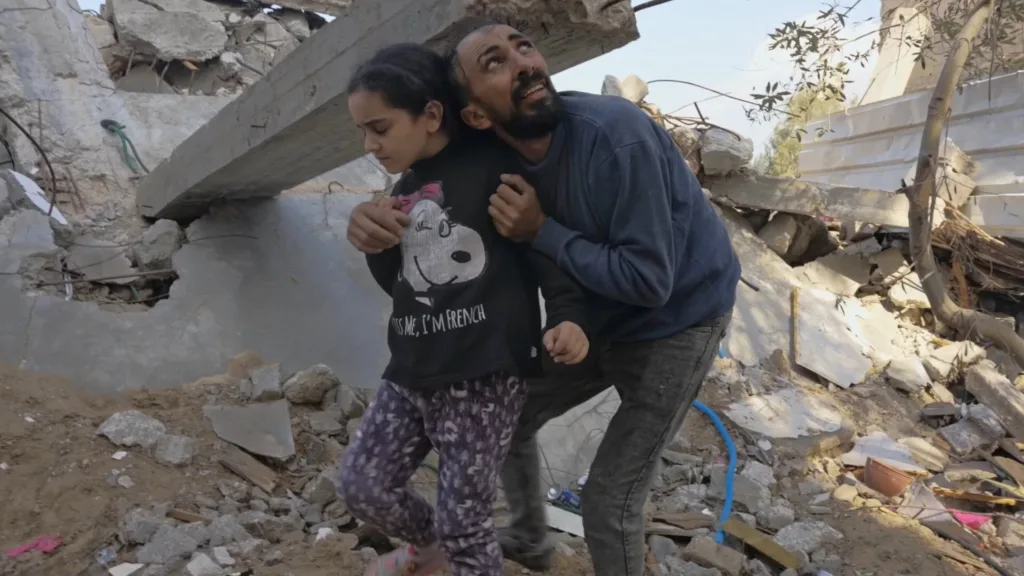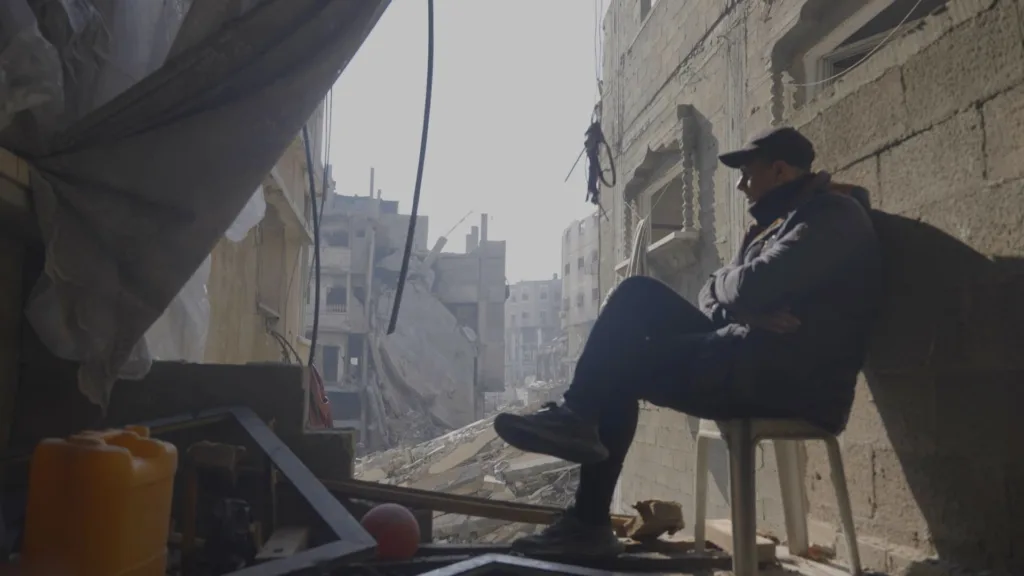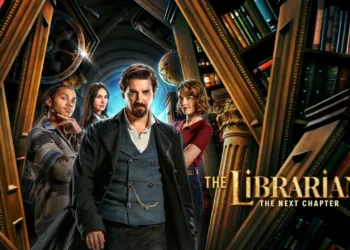From Ground Zero brings together 22 short films, each created by Palestinian filmmakers under the unrelenting pressure of ongoing conflict. Commissioned by Rashid Masharawi, this anthology reflects life in Gaza, where daily survival is a creative act.
The project showcases the realities of living in an area that faces constant bombardment, using various filmmaking techniques to capture the profound effects of this violence. The filmmakers, working with minimal resources and often using smartphones, produce a cinematic reflection of their disrupted lives—raw, authentic, and deeply personal.
Amid scenes of destruction and loss, a common theme emerges: the persistence of life and creativity in the face of ruin. The shorts are infused with a sense of memory, whether through the anguish of loved ones lost or the fleeting moments of joy found in small acts of rebellion.
These filmmakers reflect not only on survival but on the cultural continuity that can be achieved despite unimaginable hardships. Whether through improvised performances in refugee camps or intimate reflections captured with handheld cameras, From Ground Zero carries a distinct, region-specific voice.
The choice of storytelling techniques, from documentary-style footage to animated sequences, speaks to the filmmakers’ determination to communicate the urgency of their situation while maintaining a connection to their identity and history. Rather than offering a polished narrative, the anthology embraces a fragmented, yet deeply intimate portrayal of a community navigating the complexities of life under siege.
Lo-Fi Innovation: Crafting Survival in From Ground Zero
From Ground Zero is a striking demonstration of how necessity breeds innovation. The anthology brings together a spectrum of genres—documentary, fiction, and animation—each of which captures Gaza’s devastating reality. Some shorts embrace the immediacy of documentary filmmaking, creating raw, unfiltered depictions of survival under siege, while others weave fictional narratives into the rubble, using storytelling as a form of resistance.
The inclusion of animation and experimental techniques further deepens the emotional resonance, often providing a haunting contrast to the real-world destruction that surrounds the filmmakers. These diverse approaches reflect a profound cultural commitment to storytelling, using the tools at hand to document and preserve their experiences.
The filmmakers’ reliance on smartphones and minimal equipment speaks directly to the resource scarcity they face, yet this limitation becomes an intrinsic part of the film’s texture. The lo-fi aesthetic, far from being a drawback, becomes a means of expression. The handheld shots, the grainy quality, and the often jagged transitions reflect the fragmented, disrupted lives of the people they depict.
This aesthetic choice, born from necessity, mirrors the very realities of daily existence in Gaza—where the limits of resources extend far beyond technology and touch every aspect of life. The humble, imperfect nature of the visuals serves as a poignant reminder that survival itself is a fractured, ongoing process.
In this way, the film’s form is not simply a backdrop but a deliberate narrative tool. The rough edges of the filmmaking act as a visual metaphor for the resilience of Gaza’s people, creating a narrative that is both a record of trauma and a statement of defiance.
What could be seen as technical limitations instead becomes a form of resistance against the erasure of Palestinian life, a refusal to let the chaos of war destroy their voices. The very act of creating amidst such destruction speaks volumes, transforming the filmmakers’ limited resources into a powerful statement on the enduring need for expression in the face of oppression.
Survival and Resilience: The Complex Web of Life in From Ground Zero
From Ground Zero paints a powerful picture of survival amid destruction. The anthology of shorts, though varied in style, remains united in their portrayal of the fight to preserve life amidst unrelenting devastation. The recurring scenes of scavenging for basic needs highlight how daily survival transforms into a creative act.
In Sorry Cinema, for example, a filmmaker burns his clapperboard to stay warm, repurposing something meant for creation into something crucial for survival. This simple, almost poetic act reflects the resourcefulness that arises in extreme circumstances and speaks volumes about the filmmakers’ ability to preserve something of themselves, even in such dire conditions.
Alongside this physical struggle, From Ground Zero explores the emotional weight of living under constant threat. In shorts like 24 Hours and No Signal, the grief from loss is laid bare, depicting how trauma becomes a defining element of life in Gaza.
The pain of losing family members or searching through rubble for loved ones is portrayed with heart-wrenching sincerity. These moments go beyond depicting grief; they show how psychological strain becomes part of the fabric of daily life, carried in every action, from scavenging for food to enduring the constant hum of drones in the background.
However, even in the depths of destruction, moments of defiance emerge. In Everything is Fine and No, humor surfaces as a survival mechanism, a fleeting but vital respite from the overwhelming sense of hopelessness. The humor in these pieces—dark, ironic, and full of bite—offers a necessary challenge to despair, allowing the characters to push back against the harshness of their surroundings.
In more subdued instances, such as School Day, the quiet resilience of continuing everyday routines speaks volumes. Here, the simple act of learning becomes a rebellion, a refusal to let tragedy erase culture and community.
Art as Resistance: The Role of Creativity in Conflict
From Ground Zero reflects the persistence of artistic expression in the face of destruction. In Gaza, where resources are scarce and the threat of annihilation is constant, the filmmakers continue to create despite the challenges. They use whatever tools they have at hand—smartphones, handheld cameras, and basic equipment—to craft their stories.
This process of creating becomes, in itself, an act of resistance. It’s not about artistic perfection; it’s about survival through storytelling. These filmmakers refuse to be silenced, their creativity standing as a defiant response to the erasure of lives and culture caused by war.
The fusion of documentary and narrative fiction throughout the anthology offers a window into the multifaceted lives of those living under siege. Some shorts, like Everything is Fine, mix humor with the harsh realities of survival, while others, like Sorry Cinema, blend fictional stories with the truth of daily life.
This intermingling of fact and fiction provides a unique approach to filmmaking, allowing the filmmakers to communicate personal histories while avoiding the constraints of traditional genres. By bending the lines between documentary and narrative, they preserve their identities and history, challenging any notion that their stories should be relegated to mere statistics or headlines.
Animation and puppetry offer another compelling way of depicting trauma in From Ground Zero. In films like Soft Skin and Awakening, stop-motion animation and puppets tell stories of loss, grief, and survival. The use of these forms gives space for imagination, making it possible for the filmmakers to address the rawness of their lived experiences while also crafting something surreal.
These techniques blur the line between reality and imagination, allowing children and artists to process their trauma through creation. The animation in Soft Skin, for instance, portrays the harrowing experience of children living in fear of bombing, using simple cut-outs to tell stories about family separation and survival.
Similarly, Awakening uses puppet figures to represent the psychological and emotional toll of war. Through these artistic methods, the film offers an important space for storytelling that transcends the limitations of traditional forms, giving the audience a chance to witness the resilience of the human spirit.
Exploring Identity and Memory in Gaza
From Ground Zero powerfully captures the interplay between personal and collective memory, illustrating the challenge of preserving identity amidst the destruction in Gaza. The recurring theme of remembering—whether it’s through the recollection of lost loved ones or the remnants of once-thriving communities—runs through the anthology.
The filmmakers are not merely documenting daily life, but actively engaging in the preservation of experiences that seem increasingly threatened by the violence surrounding them. Each story offers an intimate glimpse into how personal histories are fought for, even when all else is crumbling.
Memory, in this sense, becomes a tool for survival and identity-building. In films like Out of Frame and Fragments, artists endeavor to preserve not only their cultural practices but also their sense of self. In Out of Frame, a painter carefully salvages the remnants of her art, clinging to the value of creation even in the face of widespread loss.
Fragments reflects a similar effort, with sketches interwoven with archival footage to maintain the continuity of the past, even when the future feels uncertain. These acts of artistic defiance point to the central role of storytelling as a means of both resisting erasure and holding onto one’s place within a broader cultural narrative.
The films also blur the lines between past and present, subtly tying personal stories to the larger historical struggles of Gaza. Through flashbacks and metaphors, filmmakers contextualize the personal experiences of trauma and survival within the long history of displacement and resistance. This overlapping of time provides a nuanced understanding of the ongoing nature of Gaza’s crises, underscoring how the personal and the historical are inseparable in shaping the lives of those who live there.
From Ground Zero: A Testimony of Survival
From Ground Zero stands out within the documentary genre for its dual role in capturing life in Gaza and asserting the importance of art in moments of crisis. The filmmakers use their craft to document the lived realities of those caught in a continuous state of war, blending art and memory with the purpose of survival.
While the film provides a sobering account of destruction, it simultaneously highlights the resilience of those who use creativity to maintain a sense of identity and continuity. With minimal resources and often under dire circumstances, the filmmakers prove that storytelling is as essential as physical survival.
The anthology doesn’t shy away from the harshness of life under siege, but it also highlights the power of art to defy the annihilation surrounding it. The act of making films under such extreme conditions reflects an unwavering commitment to recording and preserving experiences that would otherwise be lost.
The project speaks to the strength of the human spirit, demonstrating that even in the bleakest of environments, the need to create remains an enduring form of resistance. From Ground Zero offers a portrayal of survival, cultural memory, and personal defiance, transforming everyday life amidst chaos into a narrative of resilience that is both deeply local and universally human.
The Review
From Ground Zero
From Ground Zero is a powerful and evocative anthology that blends art and documentary to tell the stories of survival in Gaza. Through its lo-fi aesthetic and diverse narrative techniques, it captures the human spirit in the face of unrelenting devastation, proving that creativity remains a vital form of resistance. The film’s raw portrayal of grief, loss, and resilience offers a compelling testament to the enduring need for artistic expression, even under the most extreme conditions.
PROS
- Authentic portrayal of life in Gaza.
- Creative use of mixed media (documentary, fiction, animation).
- Highlights resilience and cultural preservation through art.
- Emotionally impactful and thought-provoking.
CONS
- Inconsistent quality due to varying short formats.
- Raw, lo-fi style may be jarring for some viewers.
- Emotionally heavy, which may be overwhelming for some.


















































